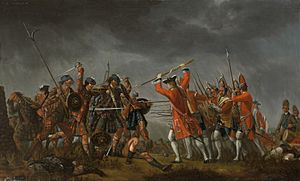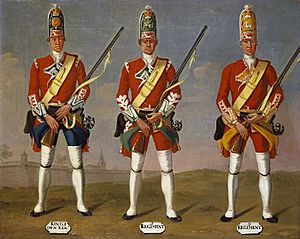An Incident in the Rebellion of 1745 facts for kids
Quick facts for kids An Incident in the Rebellion of 1745 |
|
|---|---|
| A Skirmish between Highlanders and English Infantry, The Battle of Culloden | |
 |
|
| Artist | David Morier |
| Year | 1746–1765 |
| Medium | Oil-on-canvas |
| Subject | A battle between Jacobite and government soldiers. |
| Dimensions | 60.5 cm × 99.5 cm (23.8 in × 39.2 in) |
| Location | Palace of Holyroodhouse, Edinburgh |
| Owner | Royal Collection |
| Accession | RCIN 401243 |
An Incident in the Rebellion of 1745 is an oil painting by the artist David Morier. It is part of the Royal Collection, which belongs to the British royal family. The painting shows a moment during the 1746 Battle of Culloden. In this scene, a group of Jacobite soldiers are charging towards a line of government soldiers.
Contents
Understanding the Battle of Culloden
The Battle of Culloden was the very last battle of the Jacobite rising of 1745. This uprising was an attempt by Charles Edward Stuart, also known as Bonnie Prince Charlie, to take the British throne. He wanted to replace King George II with his own father, James Francis Edward Stuart.
The battle happened on April 16, 1746. It took place on Drummossie Moor, near Inverness in the Scottish Highlands. Charles Stuart led the Jacobite Army. The government army was led by Prince William, Duke of Cumberland, who was King George II's son. The battle lasted about an hour. It ended with a big defeat for the Jacobites.
About the Painting
The artist, David Morier, was born in Switzerland. He started working for the Duke of Cumberland in 1747. He continued to receive payments from the Duke until 1767. Morier finished An Incident in the Rebellion of 1745 sometime before 1765. This painting is believed to be one of four battle scenes he painted for the Duke.
Some people think Morier might have been at the Battle of Culloden himself. Many stories say he used Jacobite prisoners as models for his paintings. However, this idea is debated. Some believe it is just a legend that started in the 1800s.
The Jacobite Soldiers in the Painting
The painting shows eight Jacobite soldiers. They are wearing 20 different types of tartan fabric. Tartan was often worn by Jacobite fighters and their supporters. It showed their Scottish identity and their clan connections. They also wear white cockades (ribbons) in their bonnets. These showed their loyalty to the Stuart family.
The Jacobite troops in the painting look like they have old-fashioned weapons. None of them carry guns. Instead, they have broadswords, dirks (small daggers), and targes (shields). Some even have Lochaber axes, which were old Scottish pole weapons. This way of showing them might have been part of the government's propaganda. It made the Jacobite Highlanders look wild and not modern.
In reality, the Jacobites were not well-armed at the start of the uprising. This was because of the Disarming Act 1715. But by the time of Culloden, France and Spain had sent them about 5,000 modern muskets and bayonets. Some Jacobites also had captured Brown Bess muskets or Scottish-made pistols. All Jacobite soldiers eventually had muskets. However, some would fire one shot, then drop their gun. They would then fight hand-to-hand with their broadswords and dirks. James Ray, who was with the government army, wrote that this happened during the fighting shown in the painting.
The Government Soldiers in the Painting
The government troops in the painting are grenadiers from the 4th King's Own (Barrell's) Regiment. This regiment fought on the left side of the government army. They were at the southern end of the battlefield. They faced the main Jacobite charge. This regiment had the most casualties on the government side. Out of 373 soldiers, 18 died and 108 were wounded. Their commander, Sir Robert Rich, 5th Baronet, was among the wounded. He lost his left hand.
You can tell these soldiers are grenadiers by their tall mitre caps. Grenadiers were usually the tallest, strongest, and most experienced men in the regiment. The soldier closest to the viewer is very noticeable. He wears a red sash, which means he is an officer. He carries a fusil, which is a smaller, lighter version of the muskets his men carry. This was common for grenadier officers. Other officers might carry a short pike or spontoon. Lord Robert Kerr was the Captain of the 4th Regiment's grenadier company. He was killed during the battle. The officer in the painting, shown in a brave pose, might be a depiction of him.
Behind the main group, you can see drummers, another officer, and more soldiers. Part of the King's Colour, one of the regiment's flags, is also visible.
Battlefield Features
At the southern end of the Culloden battlefield, where the 4th Regiment fought, there were two farm enclosures with stone walls. A small part of a stone structure can be seen on the left side of the painting. This might be part of one of those enclosures.
Where to See the Painting Now
The painting is currently displayed in the lobby of the Palace of Holyroodhouse in Edinburgh. This room holds several items related to the 1745 uprising. These include portraits of James Francis Edward Stuart and the Duke of Cumberland. There is also a painting of Charles Edward Stuart from the late 1800s. You can also see a knife and fork that belonged to him, and a sword and pistols traditionally said to be his.
A later engraving, which was based on this painting, is part of the collections at the Scottish National Gallery.


